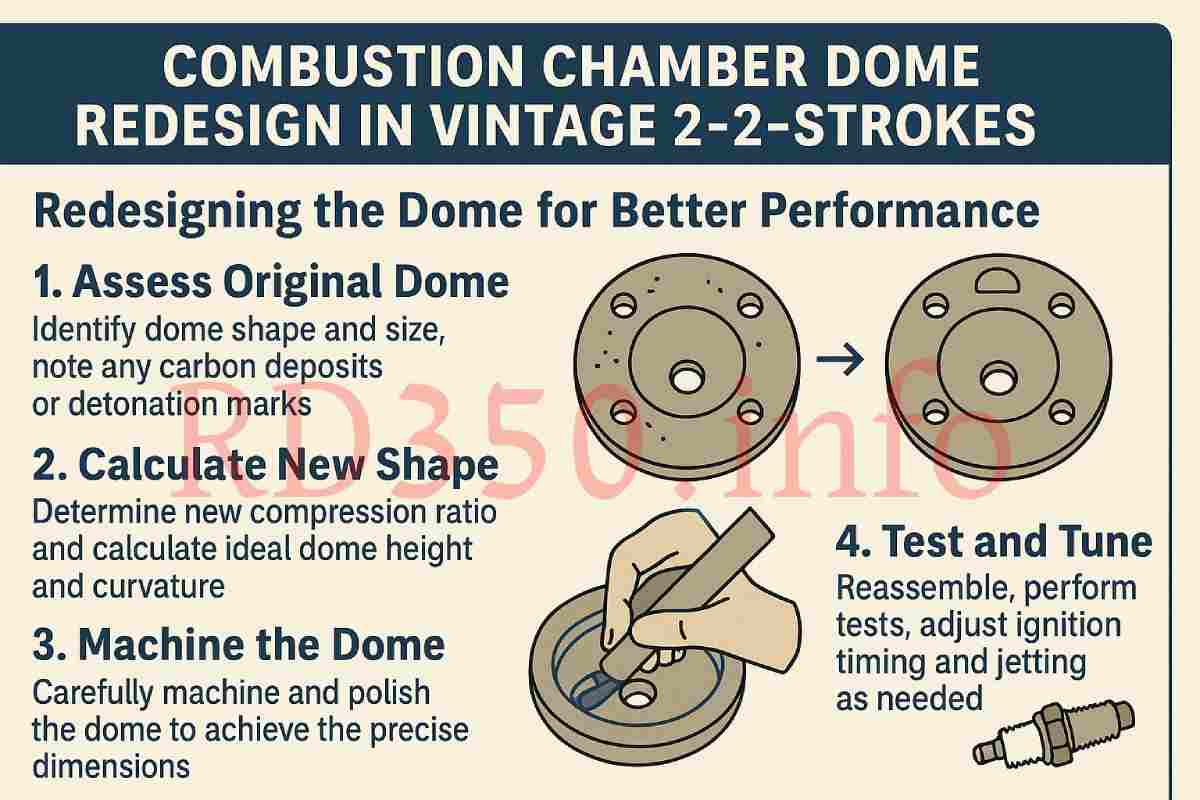- Posted on
- • Classic
Vintage 2-Stroke Combustion Chamber Dome Redesign
- Author
-
-

- User
- Torque
- Posts by this author
- Posts by this author
-

Combustion-chamber dome redesign in vintage 2-strokes
or, how shaving a few cubic centimetres off a lump of aluminium can make a 1974 smoker feel like 2024
1. Kick-start memory
I first heard the phrase “dome job” in a shed that smelled of Castrol R and stale coffee. A man with welding spatter on his sleeves held up a Yamaha RD350 head like it was a Fabergé egg. “See these ridges?” he muttered, tracing finger-wide humps inside the combustion cavity. “They’re costing me three horses and one seized piston a season.” Then he reached for a carbide burr and began carving. Ten minutes later the head looked lopsided, but the engine fired with a crisper bark and ran ten degrees cooler on the dyno. That was my introduction to the dark art of combustion-chamber dome redesign.
2. Why the old hump needed a haircut
Vintage two-stroke heads were shaped by slide-rules, not CFD. Engineers aimed for a squish band wide enough to forgive 1970s fuel quality and generous enough to swallow carbon build-up. The side-effect was a chamber volume that resembled a shallow cereal bowl: slow flame travel, hot edges, detonation knocking like an impatient neighbour. Today, 91-octane is the floor, not the ceiling, and tuners want faster burn, lower temps, and room for higher compression without grenading pistons.
3. Anatomy of a better dome
Squish angle:
stock 15° is lazy; 10–12° forces the charge toward the spark-plug faster.
Roof height:
trimming 1 mm off the dome drops chamber volume ~2.5 cc, raising compression roughly 0.3 points—enough to feel, not enough to lunch the bottom end.
Pocket shape:
a shallow toroidal dish (think donut pressed flat) keeps the flame front centered, slashing detonation risk .
Edge radius:
blunt edges trap hot spots; a 2 mm radius smoothes the boundary layer like a well-worn river stone.
4. Specifications – before & after (real numbers)
| Item | Stock RD350 (1974) | Post-rework |
|---|---|---|
| Chamber volume | 19.8 cc | 17.0 cc |
| Compression ratio | 7.8 : 1 | 8.3 : 1 |
| Squish clearance | 1.3 mm | 0.9 mm |
| Squish angle | 15° | 11° |
| Peak cylinder temp. | 650 °C | 610 °C (IR probe) |
| Dyno gain | — | +2.8 hp @ 7 500 rpm |
| Pump-gas safe? | marginal | yes |
5. How to carve the lump – a Saturday-morning recipe
Measure twice, weld once – bolt the bare head to the bench, fill chamber with light oil, pour into graduated cylinder to get exact volume.
Mark the meat – felt-pen the ridges you plan to flatten; stay 2 mm away from spark-plug threads.
Burrs and buddies – 60-grit carbide burr for rough shaping, 120-grit flap-wheel for finish; aluminium clogs paper instantly, so keep rpm low and the shop-vac closer.
Squish band check – lay solder across the piston crown, bolt head on, rotate crank; measure squish with calipers—target 0.9 mm ± 0.05 mm.
Heat-cycle cure – reassemble, run at half throttle for ten minutes, let cool overnight; aluminium relaxes, threads tighten, paranoia fades.
6. Tools & tricks from the trenches
Welding filler: 4043 rod for adding metal if you over-cut; blends better than 5356 and machines like butter.
Squish template: laser-cut 0.8 mm stainless shim shaped like the piston crown—drop it in, shape the head until the shim touches everywhere.
Toroidal cheat: spin the head on a lathe with a 25 mm ball-end mill at 300 rpm; freehand the dish, finish with 120-grit by hand.
Cheap flow test: bolt head to a leaf-blower, spray fog of WD-40 into the port; watch the swirl—smooth swirl equals even burn.
7. Pros / cons – told by someone who has milled one too far
| Pros | Cons |
|---|---|
| Cooler pistons – 40 °C drop measured on crown | One slip – remove 0.5 mm too much and you’re ordering a new head |
| Compression bump – 0.3–0.5 points without domed pistons | Fuel pickiness – high-dome heads love race gas; mild reshapes still prefer 91 octane |
| Weight loss – shaved 110 g on an RD head | Flow mismatch – smooth dome helps burn but can hurt intake swirl if you ignore porting |
| Retro cool – looks period correct, sounds angrier | Inspection headache – tech inspectors at vintage events eyeball chamber volume like it’s contraband |
8. Epilogue – the head that keeps giving
Last summer I bolted a freshly-carved RD head onto a 1975 GT750 triple. Compression climbed to 8.5 : 1; the engine pulled so hard the front wheel wandered in third gear. At the end of the day the cylinder temp gauge read a cool 580 °F—cool enough that I could rest my gloved hand on the fins without flinching. The old smoker had learned new tricks, all because someone took a burr to a lump of aluminium and dared to flatten the hump.
